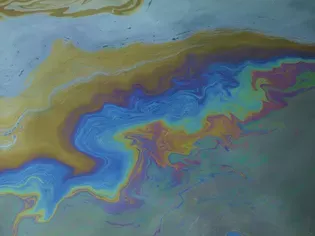How to Get Rid of Pesky Oil Slicks in Your Fish Tank
Updated on 04/26/24

The Ultimate Guide to Eradicating Pesky Oil Slicks in Your Fish Tank: A Comprehensive Guide to Pristine Waters
Oil slicks in your fish tank can be an eyesore, a nuisance, and even a health hazard to your beloved aquatic inhabitants. These unsightly films can cloud the water, block sunlight, and disrupt the delicate ecosystem of your tank. But fear not, dear aquarist! With the right knowledge and techniques, you can banish these oily invaders and restore the crystal-clear waters your fish deserve.
Understanding the Causes of Oil Slicks
Before we dive into the solutions, let's shed some light on the culprits behind these pesky oil slicks:
* Food Overfeeding: Excess food can break down and release fats, proteins, and oils into the water, creating a breeding ground for oil slicks.
* Fish Waste: Fish produce waste containing oils and fats, which can accumulate and contribute to the formation of oil slicks.
* Plant Debris: Decaying plant matter releases organic compounds that can combine with other impurities to form oil slicks.
* Poor Filtration: A clogged or insufficient filter can fail to remove oil particles, allowing them to accumulate and form slicks.
* External Sources: Oils from your hands, cleaning products, or even airborne contaminants can find their way into your tank, contributing to oil slick formation.
Step-by-Step Oil Slick Elimination Tactics
Now that we've identified the root causes, let's arm you with the tools to tackle oil slicks head-on:
1. Regular Tank Maintenance:
* Gradual Water Changes: Perform regular water changes (10-25% per week) to remove accumulated oils and other contaminants.
* Gravel Vacuuming: Use a gravel vacuum to remove decaying plant debris and food waste that can contribute to oil slick formation.
2. Dietary Adjustments:
* Feed Responsibly: Avoid overfeeding your fish. Feed them an appropriate amount and remove any uneaten food promptly.
* Consider Oil-Free Foods: Opt for fish foods that are low in oils and fats to minimize the release of oil into the water.
3. Filtration Optimization:
* Clean or Replace Filter Media: Replace or clean your filter media (e.g., sponges, cartridges) regularly to prevent clogging and ensure efficient oil removal.
* Consider an Oil-Absorbing Filter: Invest in a filter specifically designed to absorb oily substances, such as activated carbon filters or protein skimmers.
4. Natural Remedies:
* Live Plants: Aquatic plants can help absorb excess nutrients and reduce oil slicks. Try adding plants like water sprite, duckweed, or hornwort to your tank.
* Beneficial Bacteria: Introduce beneficial bacteria into your tank through products like bio-filters or live cultures. These bacteria can break down organic matter, including oils, and improve water quality.
5. Surface Skimming Devices:
* Surface Skimmer: Install a surface skimmer to remove oil slicks and other floating debris from the water's surface.
* DIY Skimmer: Create your own DIY surface skimmer using a small pump and a floating ring to trap oil slicks.
6. Chemical Solutions:
* Oil-Absorbing Granules: Add oil-absorbing granules to your filter or directly to the tank. These granules will bind to and remove oil particles.
* Activated Carbon: Activated carbon can also be used to absorb oil slicks. Place activated carbon in a filter bag or canister filter.
7. Prevention and Perseverance:
* Wash Your Hands: Always wash your hands before handling your fish or tank to prevent introducing oils from your skin.
* Use Tank-Safe Cleaning Products: Choose cleaning products specifically designed for fish tanks to avoid introducing harmful substances.
* Monitor Your Tank: Regularly observe your fish tank for any signs of oil slicks and take prompt action to address them.
Examples of Pesky Oil Slicks and Their Solutions:
* After a Heavy Feeding: If you notice oil slicks after feeding your fish, reduce the amount of food you're giving them and remove any uneaten food immediately.
* From Overcrowding: Overcrowded tanks can lead to increased waste production and oil slick formation. Consider reducing the fish population or increasing the size of your tank.
* In New Tanks: New tanks are more susceptible to oil slicks due to the lack of established beneficial bacteria. Add live plants, introduce beneficial bacteria, and perform frequent water changes.
Conclusion:
Restoring the pristine waters of your fish tank is an ongoing endeavor that requires a combination of proper maintenance, dietary adjustments, and a keen eye for prevention. By implementing the techniques outlined in this comprehensive guide, you can effectively eliminate pesky oil slicks and provide your aquatic companions with a healthy and thriving environment. Remember, a clean tank is a happy tank!
Explore More Pets

Freshwater Aquarium Filters
How to Deal With Cloudy Aquarium Water

Saltwater Aquarium Filters
How Do You Remove Chloramines From Tap Water?

Freshwater Aquariums & Habitat
Can I Keep My Koi Fish Inside?

Saltwater Aquariums & Habitat
14 Best Floating Plants for Your Aquarium

Freshwater Fish Health
How to Treat Ich on Freshwater Fish

Saltwater Fish Health
Fin Rot in Aquarium Fish

Freshwater Aquarium Filters
How to Do Aquarium Water Changes

Saltwater Fish Health
How Do Fish Get Parasites?